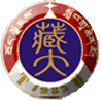Tibet SightseeingVisit Tibet 's Landmarks and Immerse in Chinese CultureInternational travelers must obtain a special permit from the Tibetan Tourism Bureau before going to Tibet.Travel outside Lhasa and the main tourism sites also require an additional travel permit when buying tickets. It is recommended that tourists visit Tibet between April and October, as the winters are very harsh and many roads become blocked due to heavy snow.Tibet covers a vast area and getting around can be difficult, but it is worth the effort in order to see the region's spectacular mountains, valleys and rivers.It is freezing cold during most of the year. Tibet's tourist industry has continued to develop and capitalize on its unique human and natural resources.The region currently has four tourist areas: Lhasa, the west, the southwest, and the south.
The Lhasa region is the spiritual and political capital of Tibet.It was first established in 633 AD and emerged as a silk trading center on the route between India and Nepal.The city is situated on a level plain on the Gyi-chu, or Happy River. Lhasa is a city of two parts.The modern Chinese area contains little of note apart from the rapidly growing number of karaoke bars, supermarkets and shops.However the traditional Tibetan quarter offers its own distinct culture, evident in its architecture, customs, language and food.
The Tibet Museum is located in the southeast corner of Norbu Lingka, Lhasa city.It covers an area of 23,508 square meters (5.8 acres) including the exhibition area of 10,451 square meters (2.6 acres) with an exhibition line of around 600 meters.
The square base foundation, representing the Buddha's lotus throne, symbolizes earth, the state of solidity and five forces of faith, concentration, mindfulness, perseverance and wisdom.The four stepped base may or may not have openings. Above the base is a square or hexagon four stepped pedestal which represents The Buddha's crossed legs.Seated on the base is the cylinder, representing his torso.This symbolizes water, the state of fluidity and seven essential conditions of enlightenment: concentration, effort, equanimity, flexibility, mindfulness, joy and wisdom. Sometimes a stupa has a shield like grillwork in one face.This allows relics of high lamas, statues and other items to be put inside.Between the cylinder and the crowning steeple, there is a square box, called Harmika, which represents the Buddha's eyes.It is considered to be the residence of the gods, symbolizing the eightfold noble path. The crowning steeple, the Buddha's crown, is usually hand-made of brass and/or covered with gold leaf.It is segmented into 13 tapering rings, a parasol and a twin symbol of the sun and the moon.Those rings, representing fire and the thirteen steps of enlightenment, successively symbolize ten powers of the Buddha and three close contemplations. The stylized parasol, representing wind, wards off all evil.At the top of the steeple is the twin symbol of the sun and the moon, which represent wisdom and method respectively.A flaming jewel may be found atop the twin symbol, symbolizing the highest enlightenment.
Now it's also a shopping center with nation characteristics.It's an old district with colorful Tibetan features.Tibetan houses line the street, and the ground is paved with man-made flagstones, preserving the ancient look.In the street, shops sell satisfactory souvenirs, and travelers can experience the mysterious "one step one kowtow" faith to religion. All the houses along the street are stores.All kinds of fantastic commodities show all aspects of the Tibetan life.Such as: Thangkas, copper Buddha, prayer wheels, butter lamps, prayer flags with sutras, beads, Tibetan joss sticks, cypress, etc. Household goods in shops are in abundant, such as: cushion, Pulu, aprons, leather bag, harness, snuff bottles, steels, Tibetan-style quilts, Tibetan-style shoes, clasp knives, Tibetan-style hats, butter, butter pots, wooden bowls, Highland Barley Wine, sweet milk tea, milk residue, air-dried beef and mutton, etc.All kinds of tourist products, cheap but good, can be found in the 1,000 meter long street. Bakhor Street is a human landscape miniature of Lhasa, even in the whole Tibet.The old circumambulation circuit is always crowded with pilgrims from everywhere.Some come along the road by performing the body long kowtows, some come by truck.Some are monks, and some are businessmen from Kham.In a word, here people come here from all over Tibet wearing different dresses, and languages.Even the similar-looking dresses of the monks vary depending on the different religions. Bakhor Street is the window to view the Tibetan area, which is silently telling the history of Lhasa.The Magyia Ngami Restaurant on the street can best reflect the civilian culture of Lhasa, the Restaurant is a bar with a good taste of art.On its wall hang works of painting, photograph, and handicraft and on the shelf there are original edition of works by Kafka and Eliot.
Built in 1416, the Drepung Monastery is considered one of the largest monasteries in the six principle monasteries of Gelu Sect in China.Drepung Monastery used to be the living palace of Dalai Lamas before the reconstruction of Potala palace (after the 5th Dalai Lamas was bestowed by Qing Emperor Qianlong).
It was believed that the statue was modeled according to the appearance of Sakyamuni and was consecrated by Sakyamuni himself.There are three life sized statues of Sakyamuni in the world.One is eight years old, another twelve years odl, and the last eighteen years old. Originally, the life sized statue of Sakyamuni aged 16 was in India, however, it sank into the Indian Ocean during the religious war.Thus, the life sized statue of Sakyamuni aged 12 is the most precious one. Songtsen Gampo constructed the Ramoche Monastery for Princess Wencheng to house the statue, and he also built the Johkang Monastery for the Nepalese Princess Khidzun.When the Princess Jicheng brought the statue of Sakyamuni from the Ramoche Monastery to the Jokhang Monastery, it became the worshipping center. After years of expansion, the Jokhang Monastery developed into
its present day scale.Lamas of Jokhang Monastery chant sutras
at night and this is worthy of listening.The life sized statue
of Sakyamuni aged 12 is the most scared stated in the eyes of
the Tibetan people.
The monastery was built by SagyaYexei, one of the disciples
of Tsongkhapa who was the founder of Gelugpa of the Tibet Buddhism
in 1419.It is one of the six main monasteries of the Gelugpa
of the Tibetan Buddhism.As one of the three main monasteries
of Lhasa, it is here that the monks "famous daily debates" take
place. Ganden monastery is the greatest and the oldest of the six Gelug Sect's monasteries, which is called one of "the three principal monasteries" (the other two are Dreprung Monastery and Sera Monastery).At its peak, it had a registration of more than 4,000 monks. Ganden monastery is the first Gelug monastery in Tibet which features rich historic monuments.Tsong Khapa, founder of Gelug Sect, established it as the first Gelug monastery in 15th century when he carried out the religious reform in Tibet. The full name of Ganden monastery is Xizhuzhuenshengzhou in Chinese.Some scholars call it as "Jushan"or "Jile" monastery.In 1733, Emperor Yongzhen of Qing dynasty bestowed the name "Yongtai".And Gandenpai (Gelug Sect's original name) which means exhortation, also named after the Ganden monastery. It was set up by the Gelug sect's founder Tsong Khapa in the 7th year of Yongle (in Ming dynasty), the Ganden monastery lies in Lhatse County, 57 kilometers east of Lhasa, the Wangbori Mountain with the altitude of 3,800 meters.Besides its typical Tibetan style, it is three times as large as Potala.
The Chambaling Monastery, in Chamdo Town, was founded in 1444 by one of Tsong Khapa's disciples.The monastery has usually kept a close relationship with past Chinese governments.It still has a brass seal granted to its abbot by Emperor Kangxi. Well preserved, Chambaling has hundreds of statues of Buddhas and great adepters, thousands of square meters of murals, and magnificent Thangkas, which represent the highest artistic level in kham.The most famous feature of the monastery is its religious dancing, which is characterized with ferocious and living masks, elegant postures, gorgeous costumes and grant scenes.It is opened 24 hours.
Namtso Lake's touching beauty should not be missed by any traveler who visits Tibet.Its purity and solemnest are symbols of Qinghai-Tibet Platean.In Tibetan, Namtso means 'Heavenly Lake.' It is considered one of the three holy lakes in Tibet.Namtso is famous for its high altitude at 4720 meters (about 3 miles), vast area of 1961 square kilometers (about 757 square miles) and beautiful scenery. Summer is the best time for Namtso Lake.Wild yaks, hares and other wild animals leisurely look for food along the expansive lake shores; countless migratory birds fly here to lay eggs and feed their young; sometimes lovely fishes in the lake jump out of the lake water, enjoying the warmth of the sunshine; sheep and cows herds are like flowing white blanks on the green grassland which can stretch as far as your eyes can see; the dulcet songs of Gauchos resound through the valleys. During summer season Namtso Lake is full of life and activity.Therefore it is no wonder Tibetans take Namtso Lake the symbol of goodliness and happiness.Really Namtso Lake is a blessing from nature.Besides the beautiful scenery, Namtso is also a famous sacred Buddhist place.There is a Zhaxi Temple in Zhaxi by land.In every Tibetan year of the sheep, thousands of Buddhism adherents will come here to worship.As a rule, they will walk clockwise along the Namtso Lake in order to receive the blessing of the gods.
Located in the Ngari Region of Tibet, Mountain Kailash and Lake Mansarova are famous as Sacred Mountain and Holy Lake respectively.Both have often been chosen as a sacrificial center for Hindu, Buddhist, and Bonist pilgrims.Their spiritual aura and paradisiacal scenery also entice ordinary tourists.
Mountain Kailash is the highest peak in the massive Gangdise mountain range with an altitude over 6,600 meters (21654 feet).The peak is very pointed and looks like a pyramid piercing the sky.Seen from the south the vertical ice trough and horizontal rock formation combine as the Buddhist symbol Swastika '…e', which represents the eternal power of Buddha.More often that not, clouds will gather above the peak, so clear days are thought to be a blessing because local residents can get an unimpeded view.
Travel Tips:One circle around the mountain is 52 km long and takes about three days.Because of the high altitude, weather changes frequently.Travelers should bring warm clothes, a tent and sleeping bag, a waterproof mattress or cushion, food items and common medicines.Camp stoves are permitted on the mountain. Lake Mansarova lies about 20 kilometers (12.43 miles) southeast of Mountain Kailash.It means 'Invincible Jade Lake' in Tibetan.The name originates from a story that Buddhism wins a victory against Bon in a religious match beside the lake.The lake is the same 'Jade Pool of Western Kingdom' described by the high monk Xuanzang of the Tang Dynasty (618-907) in his Westward Diary. The altitude of the lake is about 4,588 meters (15,052.49 feet), making it one of the highest fresh water lakes in the world.The water is very limpid and bright.The Hindu legend has that it is the amrita designed by the great god Brahma that can wash away all one's sins as well as any anxiety or improper thoughts.Many pilgrims bathe in the lake and take some water back as a gift to their relatives and friends.The surrounding area is the point of origin for India's two most famous rivers, the Indus and the Ganges. Walking around the lake also has ceremonial value for the Tibetan and always follows clockwise.There are many temples along the way, the two most notable being the Jiwu and the Chugu.Walking one circle around the lake takes about 4 days, 90 kilometers in length in all; however, wading in the cold along the way is a bit challenging.
Established in about the 10th century, the Guge Kingdom was founded by one branch of descendants of a nearby crumbled Kingdom.It was ruled by about 16 kings with armies of tens of thousands of soldiers during the over 700 years in which it flourished. Then in the 1660s, conflicts resulting from power disputes within the imperial family emerged which engendered restlessness in society and induced civil uprisings.To win power in the disordered state, the brother of the king asked the ruler of the neighboring country Ladakh to send his army to help.This army overthrew and conquered the kingdom.Years later was power returned to Tibet.During its lifetime the Guge Kingdom played an important part in the economic and cultural development of Tibet.The kingdom advocated Buddhism, and many versions of this religion were created here and their teachings were spread from here into the heart of Tibet.The kingdom also served as a major center for Tibet's foreign trade.
Except for some temples, all the roofs of the rooms have collapsed, leaving only the walls.The ruins are surrounded by a city wall and a fortress marks each of the corners.Palaces, temples and local residences are distributed from the top to the bottom and only secret roads lead to the top, a layout designed to indicate the supremacy of the king and to ensure the safety of the palaces.Due to its great research value, the Ruins of Guge Kingdom have been listed under the first group of Cultural Relics of National Importance under the Protection of the State.
Yarlong Tsangpo River originates from a glacier on the northern side of the middle Himalayas, over 5,300 meters (208,661 feet) above sea level.It runs across the south of Qinghai-Tibet Plateau from west to east, through India and Bengal, and finally flows into the Bay of Bengal. Altogether more than 2,900 kilometers (1,802 miles) long with a catchments area of 935 thousand square kilometers (361,006 square miles), it is the fifth longest river in China.With a large number of branches, its natural hydropower capacity reaches up to 79,116 thousand kilowatts, just second to the Yangtze River in China.
The Great Canyon of Yarlong Tsangpo River is absolutely a highlight.It is the largest and deepest canyon in the world, being 504.6 kilometers (314 miles) long and 6,009 meters (19,715 feet) in depth at its deepest.The average depth is 2,268 meters (7,441 feet). Nine Natural Vertical Zones ranging from the Alp Ice-snow belt to tropical seasonal forests are represented in this area.All kinds of wildlife exist here, so the Great Canyon of Yarlong Tsangpo River is regarded as 'the Gene Pool of Biological Resources', whilst enjoying fame as a 'Geological Museum' due to the various geological phenomena found.
Samye Monastery Located in the quiet piedmont area of the Shannan Region, the Samye Monastery is the first temple to be built in Tibet in 779 under the patron of Trisong Detsen.And the first completed monastery with the three Buddhist jewels of Buddha, Dharma and Sangha.With these unique features, this splendid temple has become an attraction for visitors from near and far. The temple was built by the Trisong Detsen (reigned 742-798) of the Tubo Kingdom and was presided over by the Buddhist master Padmasambhava.The Detsen contributed a lot to the project.First, it was said the name (meaning surprise in Tibetan) originated from an exclamation he made.When the temple was completed, Detsen took part in the foundation ceremony and then ordained seven descendants of blue blood to cultivate in the temple.They became the first group of monks to live at the temple and later the so-called 'Seven Enlighten Disciples of Samye'.Since then, Buddhism had become widespread within Tibet and forms a branch of splendid culture.Now, the temple is listed as one of the cultural relics of national importance under the protection of the state.
The Samye Monastery is renowned for the characteristic art of its buildings and the vivid murals as well as other ancient relics stored within them.The three-story Wuzi Hall is the soul of the whole monastery.Its design is very special.All of the layers follow different styles, the bottom Tibetan, the middle Han and the top Indian.Hence the monastery is also called the 'Three-styled Temple'.There are also many substantial murals here.On the porch of the middle story is inscribed the reputed 'Painted Historical Records' of Tibet, which extend 9.2 meters and contains the religious history of Tibet as well as many related legends.Besides these, the murals depicting the 'Historical Records of Samye Monastery' and the 'Biography of Padmasambhava' on the other two levels are also of high aesthetic value. There are four gates to the Wuzi Hall.The eastern gate leads to the front entrance of the hall.In front of the gate is a nine-story hall, however, only three stories remain standing.On the January 5 and May 16 of the Tibetan Calendar, the large embroidery of Sakyamuni is hung on the wall for people to make homage to, hence the name 'Zhanfo Dian' (Buddha Unfolding Hall).There is also an ancient stele and a bell made during the Tang Dynasty (618-907) along with a pair of stone lions.On the stele Trisong Detsen's edicts for establishing Buddhism as the state religion in 779 are recorded.The bell was the first one made in Tibetan history and is said to memorize the third concubine of the Detsen who led 30 aristocratic women to renounce the world and who later became the first group of nuns in Tibet. The Samye Monastery is located at the foot of Mount Haibu Rishen, north of the Yarlung Tsangpo River.When visiting the monastery, bring a flashlight as it is quite dark in the halls. Yamdrok Yumtso (or Yamdrok-tso), one of the three holiest lakes in Tibet, lies at Nhagartse, located about 100 kilometers (62 miles) to the southwest of Lhasa.According to legend, it was a fairy that descended to earth.Her husband followed suit and transformed into Mount Kampala.Besides Mount Kampala, Yamdrok Yumtso is also surrounded by Mount Nyinchenkhasa, Mount Chetungsu and Mount Changsamlhamo.
On the surrounding expansive pasture, animals and birds flourish in huge numbers.There are dozens of islets in the lake, on which flocks of birds roost.During the herding season, the local herdsmen will ferry their herds of sheep across to these islets since there aren't any predators on these islets, and leave them there until the onset of winter. The holy lake is also a pilgrimage site for Tibetans.Every summer, gangs of pilgrims trek there to pray and receive blessings.Pilgrims believe that its water can make the old young again, grant the middle-aged a longer life and make the children smarter.Being a sacred lake, the color of its water may be taken by the devout as having spiritual meaning. Tibetans will usually visit the lake before making important decisions.On one of the islets, stands a Nyinmapa monastery.South of the lake, one finds the Sangding Monastery, which is famous as the residence of the only female high lama in Tibet.
Palkhor Monastery
Tshomchen, the Main Assembly Hall of Palkhor, was built between the end of fourteenth century and the beginning of the fifteenth century.The ground floor of the three story building is a Chanting Hall with 48 columns, which are decorated with old silk "thangkas".An eight-meter high (26 feet) bronze statuary of Maitreya is also on display.The gilded figure is made from 1.4 tons (3086 pounds) of bronze. On the second floor, "Bodhisattva Manjushri" and "Arhats", from the Ming dynasty (1368-1644), were enshrined in the chapels.Its Arhat Chapel is famous throughout Tibet.On the roof, a chapel houses a collection of 15 "mandala" murals, which are three meters (ten feet) in diameter.Additionally, the monastery collects about 100 robes and costumes worn in Tibetan opera, all of which were made of silk, embroidery and tapestry during the Ming dynasty (1368-1644) and the Qing dynasty (1644-1911). The monastery houses monks from the Gelugpa, Sakyapa and Kahdampa orders.Although they once quarreled and fought, the different orders eventually discovered a way to get along with each other.The monastery is the only one known to house monks from different orders in harmony.As a result, its structural style, deities enshrined and murals are very special. Tashilhunpo Monastery Tashilhunpo Monastery covers an area of nearly 300,000 square meters (3,229,279 square feet.).The main structures found in the Tashilhunpo Monastery are The Maitreya Chapel, The Panchen Lama's Palace and The Kelsang Temple.Tashilhunpo is the seat of the Panchen Lama since the Fourth Panchen Lama took charge in the monastery, and there are now nearly 800 lamas. Standing on the entrance of Tashilhunpo, visitors can see the grand buildings with golden roofs and white walls.The remarkable Thangka Wall which is nine floors high was built by the First Dalai Lama in 1468.The wall displays the images of Buddha on the 14th, 15th and 16th of May every year following the Tibetan Lunar Calendar.The images are so humongous that one can easily see it in Shigatse City. Visitors can find The Maitreya Chapel by strolling into the monastery on the west side of Tashilhunpo.One can find the biggest statue of a sitting Maitreya Buddha inside the chapel.The statue stands 26.2 meters (86 feet) high and is decorated with gold, copper, pearl, amber, coral, diamond and other precious stones.The statue was handcrafted by 900 craftsmen in 9 years.The chapel has been divided into five floors.Visitors can tour the upper floors of the chapel using a wooden staircase to see the statue more clearly and appreciate the superb skill of the Tibetans. |

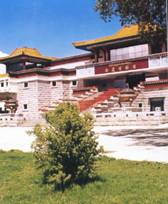 Tibet museum was officially inaugurated in October of 1999,
with a permanent collection that celebrates the History of Tibetan
Culture.The design of the exhibit uses traditional Tibetan
architecture such as Tibetan doors, beam-decoration, patterns
and so on, in order to create the atmosphere of authentic Tibetan
art.
Tibet museum was officially inaugurated in October of 1999,
with a permanent collection that celebrates the History of Tibetan
Culture.The design of the exhibit uses traditional Tibetan
architecture such as Tibetan doors, beam-decoration, patterns
and so on, in order to create the atmosphere of authentic Tibetan
art.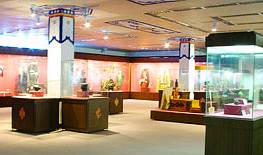 The museum is equipped with modern facilities to ensure quality
service for visitors and safety and efficient administration
of the museum itself.This exhibit displays around 1,000 precious
objects.The contents are divided into pre-history culture,
indivisible history, culture and arts, and people's customs.The exhibits are introduced in Japanese, English, Tibetan, and
Chinese, in order to accommodate visitors from all over the world.
The museum is equipped with modern facilities to ensure quality
service for visitors and safety and efficient administration
of the museum itself.This exhibit displays around 1,000 precious
objects.The contents are divided into pre-history culture,
indivisible history, culture and arts, and people's customs.The exhibits are introduced in Japanese, English, Tibetan, and
Chinese, in order to accommodate visitors from all over the world. Stupa is an important religious monument in Tibet.This unique
religious architectural form expresses significant religious
symbolism and presents Buddha's physical presence.It generally
consists of three parts; a whitewashed base, a whitewashed cylinder
and a crowning steeple or shaft.
Stupa is an important religious monument in Tibet.This unique
religious architectural form expresses significant religious
symbolism and presents Buddha's physical presence.It generally
consists of three parts; a whitewashed base, a whitewashed cylinder
and a crowning steeple or shaft.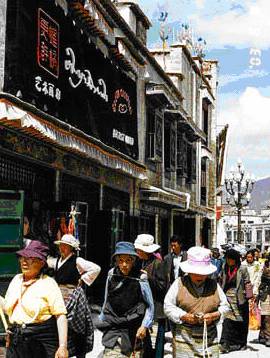 Barkhor, a circular street at the center of Old Lhasa, is the
oldest street in a very traditional city in Tibet.In the past,
it was only a circumambulation circuit, "a saint road" in the
eyes of Tibetan.
Barkhor, a circular street at the center of Old Lhasa, is the
oldest street in a very traditional city in Tibet.In the past,
it was only a circumambulation circuit, "a saint road" in the
eyes of Tibetan.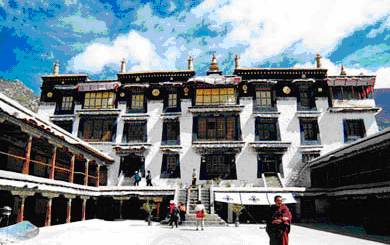 Drepung Monastery is the largest and richest monastery in Tibet.It lies in west of Lhasa under Mount Gambo Utse, clustered round
by the black mountain, its white grand buildings shining under
the sunlight.
Drepung Monastery is the largest and richest monastery in Tibet.It lies in west of Lhasa under Mount Gambo Utse, clustered round
by the black mountain, its white grand buildings shining under
the sunlight. Located in the center of old Lhasa city, the Johkang Monastery
is a prime seat of the Gelugpa (Yellow) of the Tibetan Buddhism.It was first built in 647 AD.In 643 AD, eighteen year old Princess
Wencheng in from the Tang Dynasty reached Lhasa.She brought
with her a life sized statue of Sakyamuni at the age of 12.
Located in the center of old Lhasa city, the Johkang Monastery
is a prime seat of the Gelugpa (Yellow) of the Tibetan Buddhism.It was first built in 647 AD.In 643 AD, eighteen year old Princess
Wencheng in from the Tang Dynasty reached Lhasa.She brought
with her a life sized statue of Sakyamuni at the age of 12. Norbulingka, meaning "Treasure Park", was first built
in the 1740s.Norbulingka is named the Summer Palace, located
west of Lhasa.The beautiful garden was first built in the middle
18th century.That's where religious affairs and activities
were held.The garden covers an area of 46 acres, with 370 rooms
of different sizes.In the garden people worship Buddha, spend
their holiday, and study the Tibetan style palaces.
Norbulingka, meaning "Treasure Park", was first built
in the 1740s.Norbulingka is named the Summer Palace, located
west of Lhasa.The beautiful garden was first built in the middle
18th century.That's where religious affairs and activities
were held.The garden covers an area of 46 acres, with 370 rooms
of different sizes.In the garden people worship Buddha, spend
their holiday, and study the Tibetan style palaces.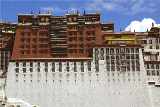 The first place in Lhasa to visit is the Potala Palace, traditionally
the winter home of the Dalai Lama and recognized as one of the
architectural wonders of the world.Built in the 7th century
and renovated in 2005, it contains thousands of rooms, Buddhist
sculptures, frescoes and scriptures.Inside the white walls
are a series of gilded mausoleums in which the bodies of previous
Dalai Lamas are entombed.
The first place in Lhasa to visit is the Potala Palace, traditionally
the winter home of the Dalai Lama and recognized as one of the
architectural wonders of the world.Built in the 7th century
and renovated in 2005, it contains thousands of rooms, Buddhist
sculptures, frescoes and scriptures.Inside the white walls
are a series of gilded mausoleums in which the bodies of previous
Dalai Lamas are entombed.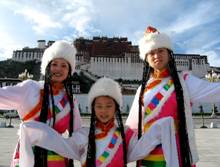 The Potala Palace, which is now on the list of Chinese national
key protected cultural relics, is the most valuable storehouse
in Tibet.It is a huge treasure house for materials and articles
of Tibetan history, religion, culture and arts.The Palace is
widely known for the precious sculptures, murals, scripture,
Buddha figures, murals, antiques, and religious jewelry treasured
up, they are of great cultural and artistic value.In 1994,
the Potala Palace was declared the United Nations World Cultural
Heritage site and a designated Unesco World Heritage site.
The Potala Palace, which is now on the list of Chinese national
key protected cultural relics, is the most valuable storehouse
in Tibet.It is a huge treasure house for materials and articles
of Tibetan history, religion, culture and arts.The Palace is
widely known for the precious sculptures, murals, scripture,
Buddha figures, murals, antiques, and religious jewelry treasured
up, they are of great cultural and artistic value.In 1994,
the Potala Palace was declared the United Nations World Cultural
Heritage site and a designated Unesco World Heritage site.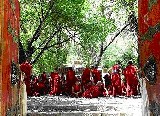 One of the three largest monasteries of Gelugpa, sits at the
foothills of Tatipu. The Sera Monastery is the representative
monastery of the Gelugpa of the Tibetan Buddhism.It lies on
the southern slope of the Serawoze Mountain in the northern suburbs
of Lhasa.
One of the three largest monasteries of Gelugpa, sits at the
foothills of Tatipu. The Sera Monastery is the representative
monastery of the Gelugpa of the Tibetan Buddhism.It lies on
the southern slope of the Serawoze Mountain in the northern suburbs
of Lhasa. The Heavenly Lake Namtso is located near Damxung.Heavenly Lake Namtso
is the highest saltwater lake in the world and the second largest saltwater
lake in China.On November 14, 2005, Namtso Lake in the Tibet Autonomous
Region was selected as one of the five most beautiful lakes in China
by Chinese National Geography magazine.
The Heavenly Lake Namtso is located near Damxung.Heavenly Lake Namtso
is the highest saltwater lake in the world and the second largest saltwater
lake in China.On November 14, 2005, Namtso Lake in the Tibet Autonomous
Region was selected as one of the five most beautiful lakes in China
by Chinese National Geography magazine. Kailash means 'Treasure or Saint of Snow Mountain' in Tibetan.The
name originates from the year-round snow on its peak and its historical
religious connections.The mountain is sometimes called 'Mother of
Iceberg'.It appears to be gazing at another mountain, Namcha Barwa,
or 'Father of Iceberg' in the far distance.
Kailash means 'Treasure or Saint of Snow Mountain' in Tibetan.The
name originates from the year-round snow on its peak and its historical
religious connections.The mountain is sometimes called 'Mother of
Iceberg'.It appears to be gazing at another mountain, Namcha Barwa,
or 'Father of Iceberg' in the far distance. Legend has it that a high lama named Milarepa competed with Naro Bonchung,
the leader of Bon,
for supernatural power.Milarepa was triumphant and thus the mountain
came under the guidance of Buddhism.However, the mountain is also
said to be the gathering place of masses of gods, among which are the
highest gods of Hinduism.So it is no surprise that many pilgrims of
different faiths visit here.
Legend has it that a high lama named Milarepa competed with Naro Bonchung,
the leader of Bon,
for supernatural power.Milarepa was triumphant and thus the mountain
came under the guidance of Buddhism.However, the mountain is also
said to be the gathering place of masses of gods, among which are the
highest gods of Hinduism.So it is no surprise that many pilgrims of
different faiths visit here. Walking around the mountain is a popular ceremony despite the length
and difficult terrain.According to the sayings of Buddhism, one circle
around the mountain can atone for all the sins committed throughout
one's lifetime.Completing ten circles around the mountain will prevent
eternal damnation of hell tribulation in one's reincarnations of 500
years.Completing one hundred circles will make a person one with Buddha.While walking, Buddhists follow clockwise while Bonists proceed in a
counter-clockwise direction.In the horse year when Sakyamuni, the
founder of Buddhism, is said to be born, worshippers get credit for
thirteen circles for every one completed.Naturally, these years draw
the largest number of tourists.
Walking around the mountain is a popular ceremony despite the length
and difficult terrain.According to the sayings of Buddhism, one circle
around the mountain can atone for all the sins committed throughout
one's lifetime.Completing ten circles around the mountain will prevent
eternal damnation of hell tribulation in one's reincarnations of 500
years.Completing one hundred circles will make a person one with Buddha.While walking, Buddhists follow clockwise while Bonists proceed in a
counter-clockwise direction.In the horse year when Sakyamuni, the
founder of Buddhism, is said to be born, worshippers get credit for
thirteen circles for every one completed.Naturally, these years draw
the largest number of tourists. Located in the Ngari Region, Tibet Autonomous Region£¬Ruins of Guge
Kingdom are the Old Summer Palace of Tibet.The ruins lie on a hilltop
near a river and cover 180,000 square meters.While these ruins were
once an imperial estate which fell into disrepair after the civil revolt
and the invasion of the allied armies of eight foreign countries, the
Guge Kingdom also encountered civil strife and foreign attacks which
fragmented the once prosperous state.However, the legendary kingdom
hasn't been totally lost as much can be learned about it from its remains.
Located in the Ngari Region, Tibet Autonomous Region£¬Ruins of Guge
Kingdom are the Old Summer Palace of Tibet.The ruins lie on a hilltop
near a river and cover 180,000 square meters.While these ruins were
once an imperial estate which fell into disrepair after the civil revolt
and the invasion of the allied armies of eight foreign countries, the
Guge Kingdom also encountered civil strife and foreign attacks which
fragmented the once prosperous state.However, the legendary kingdom
hasn't been totally lost as much can be learned about it from its remains. The Ruins of Guge Kingdom now extend around the sides of a mountain
more than 300 meters (984 feet) high.Explorers have found over 400
rooms and 800 caves here, as well as some fortresses, secret paths,
pagodas, arm storerooms, granaries and all kinds of burial places.
The Ruins of Guge Kingdom now extend around the sides of a mountain
more than 300 meters (984 feet) high.Explorers have found over 400
rooms and 800 caves here, as well as some fortresses, secret paths,
pagodas, arm storerooms, granaries and all kinds of burial places. There is a Galaxy in the heaven and a Sky River (Tianhe) on the earth,
which is called Yarlong Tsangpo River.In Chinese, Yarlong Tsangpo
River means water flowing down from the crest.Found in the Qinghai-Tibet
Plateau, known as 'the roof of the world', the Yarlong Tsangpo River
is the biggest river in Tibet and also holds the position as being the
river found at the highest altitude across the world.
There is a Galaxy in the heaven and a Sky River (Tianhe) on the earth,
which is called Yarlong Tsangpo River.In Chinese, Yarlong Tsangpo
River means water flowing down from the crest.Found in the Qinghai-Tibet
Plateau, known as 'the roof of the world', the Yarlong Tsangpo River
is the biggest river in Tibet and also holds the position as being the
river found at the highest altitude across the world. Yarlong Tsangpo River Valley is rich in forest resources, owning 2,644
thousand hectares of virgin forest.Rare and unique plants and animals
along with a natural treasure house of wildlife such as yew and Zoraptera
insects can be found here.From the Pottery shard and stone objects
of the Neolithic Period discovered in Nyingchi County, the ancient culture
of Yarlong Tsangpo River can be traced back thousands of years.To
some extent, it is the cradle of Tibetan civilization.
Yarlong Tsangpo River Valley is rich in forest resources, owning 2,644
thousand hectares of virgin forest.Rare and unique plants and animals
along with a natural treasure house of wildlife such as yew and Zoraptera
insects can be found here.From the Pottery shard and stone objects
of the Neolithic Period discovered in Nyingchi County, the ancient culture
of Yarlong Tsangpo River can be traced back thousands of years.To
some extent, it is the cradle of Tibetan civilization.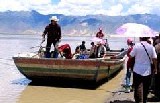 The whole construction of the temple is very grandiose and complicated.It replicates the universe described in the sutras exactly.The central world Mount Meru is represented by the majestic Wuzi Hall.The Sun and Moon chapels stand in the north and south as the sun and
moon in the universe.Four larger halls and eight smaller halls are
distributed around all sides of the central hall, symbolizing the four
large continents and eight small ones.In the four corners lie the
Red, White, Black and Green Pagodas guarding the Dharma like the Heavenly
Kings.A circular wall surrounds the temple as if marking the periphery
of the world.The layout of Samye Monastery resembles the Mandala in
the Esoteric Buddhism.
The whole construction of the temple is very grandiose and complicated.It replicates the universe described in the sutras exactly.The central world Mount Meru is represented by the majestic Wuzi Hall.The Sun and Moon chapels stand in the north and south as the sun and
moon in the universe.Four larger halls and eight smaller halls are
distributed around all sides of the central hall, symbolizing the four
large continents and eight small ones.In the four corners lie the
Red, White, Black and Green Pagodas guarding the Dharma like the Heavenly
Kings.A circular wall surrounds the temple as if marking the periphery
of the world.The layout of Samye Monastery resembles the Mandala in
the Esoteric Buddhism. Befitting its mythical feminine origins, the turquoise blue lake has
indescribable scenic beauty, prompting the Tibetans to compare it with
the fairyland in heaven.The lake is also called Coral Lake of the
Highlands due to its shape.The charming lake produces abundant aquatic
life.
Befitting its mythical feminine origins, the turquoise blue lake has
indescribable scenic beauty, prompting the Tibetans to compare it with
the fairyland in heaven.The lake is also called Coral Lake of the
Highlands due to its shape.The charming lake produces abundant aquatic
life. Palkhor Monastery, also named Palcho Monastery, is very different from
other monasteries.It lies about 230 kilometers (143 miles) south of
Lhasa and 100 (62 miles) east of Shigatse at the foot of Dzong Hill.Built as a Tibetan monastery, its structural style is very unique.
Palkhor Monastery, also named Palcho Monastery, is very different from
other monasteries.It lies about 230 kilometers (143 miles) south of
Lhasa and 100 (62 miles) east of Shigatse at the foot of Dzong Hill.Built as a Tibetan monastery, its structural style is very unique. Tashilhunpo Monastery is one of the Six Big Monasteries of
Gelugpa (or Yellow Hat Sect) in Tibet.Also called the Heap of Glory,
the monastery is located at the foot of Drolmari (Tara's Mountain),
Shigatse.Founded by the First Dailai Lama in 1447, the monastery's
structure was expanded by the Fourth and successive Panchen Lamas.
Tashilhunpo Monastery is one of the Six Big Monasteries of
Gelugpa (or Yellow Hat Sect) in Tibet.Also called the Heap of Glory,
the monastery is located at the foot of Drolmari (Tara's Mountain),
Shigatse.Founded by the First Dailai Lama in 1447, the monastery's
structure was expanded by the Fourth and successive Panchen Lamas.